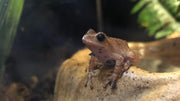
Have you ever been mesmerized by the serenading chorus of spring peepers on a crisp evening? Besides being one of the pleasant indications of spring, these little frogs are part of your pond's ecosystem. But have you ever thought, "How far do spring peeper hibernate away from ponds?" Understanding their habits of hibernation will further help in making the environment more supportive for these charming amphibians. In this article, we’ll delve into the hibernation behaviors of spring peepers, explore the factors influencing their migration distances, and offer tips to ensure your pond remains a safe haven for these delightful frogs.
What Are Spring Peepers?
Spring peepers are small-sized chorus frogs native to North America but find most of their abundance in the eastern part of the United States and parts of Canada. They have this characteristic high-pitched call, mainly during the breeding time, and therefore appear to be one of the first frogs in spring. In their bright green or brown color, they have small black spots and are rather unmistakable near ponds and wetlands.
Key Characteristics:
· Size: Generally 0.75 to 1.5 inches long.
· Habitat: Shallow ponds, marshes, and wet meadows are preferred.
· Diet: Insectivorous, feeding on flies, mosquitoes, and other small invertebrates.
Hibernation Behavior of Spring Peepers
With cold winters, spring peepers enter into a life stage called hibernation for survival under such hostile weather conditions. Unlike many other amphibians, some of which migrate over long distances, spring peepers show specific hibernation patterns closely connected with their local environments.
Basic About Hibernation:
· Time: Typically from late fall into early spring.
· Location: Migrate to safety in moist environments to overwinter, but will not wander too far from breeding sites to return easily in the spring.
How Far Do Spring Peepers Hibernate Away from Ponds?

One of the common questions among enthusiasts is, "How far away from ponds can spring peepers hibernate?" The exact distance depends on a number of factors; yet, generally speaking, these frogs hibernate relatively close to where they breed.
Distances of Hibernation:
· Proximity: Spring peepers usually hibernate within 10 to 50 feet of their breeding ponds.
· Microhabitats: For the most part, they prefer humid locations for hibernation, such as under logs, leaf litter, or thick vegetation near the pond, to avoid predation and extreme temperatures.
Why Stay Nearby?
There is ease in some reasons for staying near:
· Easy Return: The proximity to the breeding site enables them to return with the increase in temperature and the start of the breeding seasons.
· Resource Availability: Nearby hibernation sites ensure feeding resources as soon as active life commences.
· Predator Avoidance: Hibernation in close proximity minimizes the risk of encountering predators that might range further away from the pond.
Factors Affecting Hibernation Distance
A number of environmental and biological factors determine how far spring peepers will move from their ponds to hibernate:
1.Habitat Quality
Good habitats with sufficient cover and moisture allow spring peepers to hibernate closer to their ponds. Poor habitats will force them to move further afield in search of suitable hibernation sites.
2.Climate
In colder climates, spring peepers may hibernate closer to the pond to take advantage of the moderated temperatures of the latter. In milder climates, they could be more dispersed without strong risks.
3.Population Density
High spring peeper populations would lead to a scenario whereby frogs are hibernating closer, while sparse populations would see individuals spread out for reduced competition.
4. Predation Pressure
Higher predation risk near the pond would allow spring peepers to search for more secluded hibernation spots slightly farther away while remaining in safe distances from their point of origin.
Importance of Hibernation Patterns to Pond Ecosystems

Knowing how far away spring peepers hibernate from the pond will be critical to maintaining the ecosystem in balance. Their hibernation behaviors impact their survival, reproductive success, and overall impact on the health of the pond.
Ecological Roles:
· Pest Control: Spring peepers are usually effective in controlling pest populations, especially mosquitoes and other insects, around the pond.
· Nutrient Cycling: The locomotion and metabolic products support nutrient cycling, which will be helpful in plant growth and good water quality.
· Prey for Predators: Spring peepers are prey for several predators, thus ensuring continuity in the food web.
Ensuring that spring peepers have safe and accessible hibernation sites helps preserve these ecological roles, contributing to a healthier and more resilient pond environment.
Enhancing Pond Health with POPOSOAP Products

Water quality and habitat conditions are very important to maintain a balanced pond ecosystem for spring peepers and other organisms. POPOSOAP offers a variety of eco-friendly products to support a healthy pond environment, enhancing mutualistic relationships and overall aquatic health.
Providing a Safe Hibernation for Spring Peepers
Knowing how far from ponds spring peepers hibernate is important as it will help in trying to balance the ecosystem in the pond and around it. By knowing these various hibernation distances of these frogs, and what influences these behaviors, you can proactively go about looking after these lovely frogs through the year.
With POPOSOAP, the creation of a pond environment that would provide ample cover, maintain quality water, and integrate natural habitat structures ensures safety and access for hibernation sites near their breeding grounds in the spring. Let POPOSOAP products take your pond health to the next level, filled with mutual relationships that will bloom into a very diverse and robust aquatic ecosystem.










